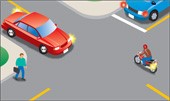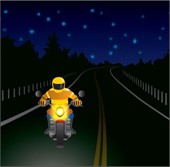Dealing with particular situations
This chapter tells you how to deal with particular driving situations you will encounter. This includes freeway driving, driving at night and in bad weather. It gives you tips for driving on dangerous and difficult surfaces, driving in a group and carrying passengers or cargo.
Starting on a hill when driving a motorcycle with clutch and gears
Starting a motorcycle with a clutch and gears on a hill is more difficult than on level ground. Follow these steps to avoid stalling or rolling backward:
- Use the front brake to hold the motorcycle while you start the engine and shift into first gear.
- Change to the foot brake to hold the motorcycle while you operate the throttle with your right hand.
- Twist the throttle a little bit for more power.
- Release the clutch gradually. If you release it too quickly, the front wheel may lift off the ground or the engine may stall, or both.
- Release the foot brake when the clutch begins to engage.
Vehicles turning left in front of you
One of the most common causes of collisions between motorcycles or mopeds and cars is the car driver turning left in front of the motorcycle or moped. This is because the car’s driver either does not see the motorcycle or moped or misjudges its speed. You can help to avoid such collisions by following these steps:
- Prepare to slow down and proceed with caution if you are going faster than a driver would expect when you approach an intersection with a vehicle waiting to turn left.
- Take a defensive lane position. Move as far as possible to the right to give a little more room between you and the vehicle.
- Think about what you will do if the car turns in front of you. Where will you go? Is there a clear area to swerve? How fast will your motorcycle stop on the road surface?
- Do not focus only on the left- turning vehicle. Pay attention to everything going on around you. Check to make sure there is nothing else in the intersection that could cause trouble, such as another vehicle or a pedestrian.

Driving at night
Driving a motorcycle or moped at night can be risky. You cannot see or be seen as well as you can in the daytime. Because of their inexperience, Level One (M1) drivers are not allowed to drive at night.
Another major problem for motorcycle and moped drivers when driving at night is alcohol. There are more drinking drivers on the road to put you at risk. And some motorcycle and moped drivers put themselves at risk by drinking. Alcohol reduces your ability to control your vehicle and to anticipate trouble from other drivers. Follow these tips for driving at night:
- Keep your headlight(s) clean, and switch to your high beam when- ever you are not following or approaching another vehicle. Get as much light as you can.
- Wear reflective clothing, such as a reflective vest and helmet. Also, wear warmer clothing when riding at night.
- Reduce your speed, particularly on roads that you do not know well. If there is something lying on the road ahead, you may not see it in time to avoid it.
- Use the lights of the vehicle in front of you to get a better view of the road ahead. Watch the movement of the vehicle’s tail lights as well. Tail lights bouncing up and down can alert you to bumps or rough pavement.
- Increase your distance from other vehicles. You cannot judge distance as well at night. Make up for this by allowing extra distance between you and other vehicles. Give yourself more distance to pass.

Overdriving your headlight(s)
You are overdriving your headlight(s) when you go so fast that your stopping distance is farther than you can see with your headlight. This is a dangerous thing to do, because you are not giving yourself enough room to make a safe stop. Reflective road signs can mislead you as well, making you believe you can see farther ahead than you actually can. This may cause you to overdrive your headlight if you are not careful.